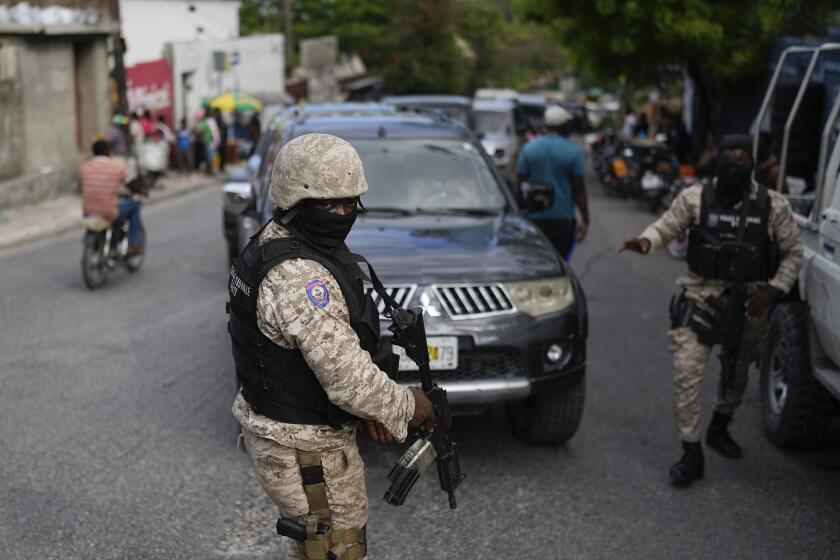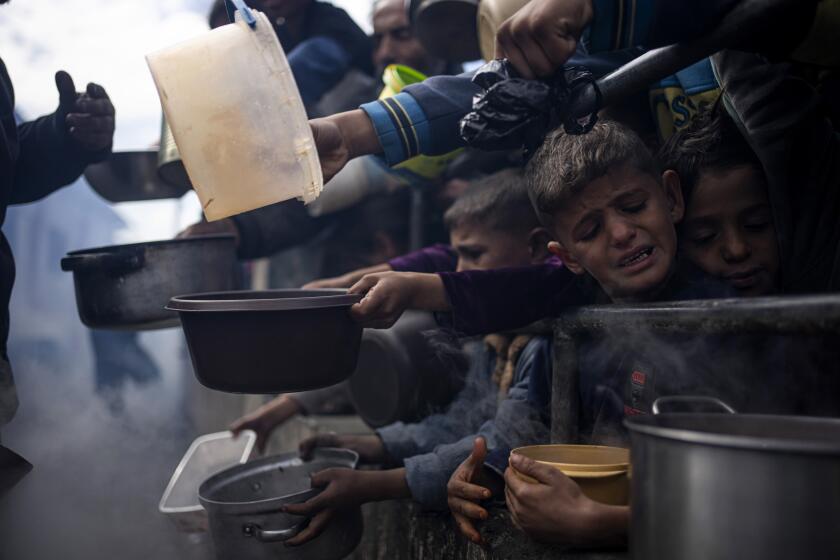‘We Have Been Fighting Nonstop’
On the top floor of the “Apache Hilton” in downtown Najaf, U.S. Army sniper Paul Buki ended a 24-hour shift by collapsing into a pile of dust, bullet casings and empty military food packages.
From this penthouse perch in a half-built tourist hotel -- seized and nicknamed by U.S. troops -- the Army staff sergeant has an unobstructed view of Najaf’s Old City, a historic district in Iraq’s holiest city that over the last week has been transformed into a war zone.
With the gold-domed Imam Ali Mosque in the background, smoke and flames rose Tuesday from a building still burning more than 15 hours after the previous night’s fighting. Two Apache helicopters swooped down through a deserted street and disappeared behind a three-story building. Mortar rounds, tank cannons and machine guns boomed and cracked throughout the day as U.S. forces battled followers of Shiite Muslim cleric Muqtada Sadr.
“It’s been intense here,” said Buki, covered in a ghostly white dust after a night spent huddled behind a brick wall, firing at militants and reporting hostile positions from his fifth-floor lookout.
In the struggle to remove Sadr’s militia from the mosque, some of the most heated clashes have shifted from the cemetery where major fighting began to a neighborhood of the Old City just south of the shrine.
“We have been fighting nonstop,” said Lt. Col. Jim Rainey, commander of the 2nd Battalion, 7th Cavalry Regiment, whose 800 soldiers have been battling street by street to seize control of the area south and east of the mosque.
In the cramped ancient city, hand-to-hand combat has been unavoidable.
During a raid Monday, U.S. troops swarmed into the basement of a school building now occupied by the militia. The troops were unaware that the militia was using tunnels to move in and out.
Catching each other by surprise, a 240-pound Army sergeant, a native of Samoa, and a 130-pound militia member found themselves face to face, said Maj. Tim Karcher, operations officer of the unit.
“He beat the snot out of the guy,” Karcher said.
But during the fight, another militia member tossed a grenade into the basement, killing a comrade and seriously injuring the sergeant, who was evacuated for treatment.
On average, Rainey said, his troops are attacked about three dozen times a day with mortar shells, small arms and rocket-propelled grenades.
“We see a lot of activity during the day,” said 1st Lt. Jimmy Campbell, part of the scout platoon based in the commandeered hotel. Not long after he spoke, a militant sniper’s bullet pinged into the lobby where troops were hanging out. It hit a wall.
“We’re used to it,” Campbell said with a shrug. “They never hit anything.”
There are no showers and no chow hall. Soldiers eat MREs -- meals ready to eat -- and shower with bottles of water, heated by the 115-degree temperatures.
Out front is a sign, “Apache Hilton,” hand-painted by Alpha Company, which inhabited the space before moving closer to the mosque a few days ago.
As Rainey moved his soldiers closer to the holy site, he noticed that the resistance increased. The artillery used in the mortar attacks went from 60-millimeter to 120-millimeter.
So far, no one in the 2nd Battalion, 7th Cavalry Regiment has been killed in action.
The toll on the neighborhood, however, has been heavy.
It’s unclear how many civilians have died; the military does not compile figures. Iraqi Health Ministry officials say dozens of civilians have been killed since the fighting in Najaf resumed nearly three weeks ago.
Though some areas of the city have returned to normal, residents in parts of the Old City say they live in fear. Sidewalks are covered with broken glass from storefront windows. The bombing has exposed interior walls of buildings. A traffic cop’s stand lies toppled in the street.
Rainey said that U.S. troops had taken “excruciating pains” to avoid damaging civilian buildings but that it was unavoidable.
“It’s like playing tackle football in a hallway,” he said.
Over the last day, the militants’ resistance appears to have waned, officials said.
U.S. troops were optimistic that Sadr’s militia was starting to fold.
“They’ve stopped maneuvering on us,” Karcher said. “We have to go out there and find them.”
The militants’ tactics are also growing more frantic, U.S. officials said.
Last weekend, militia fighters tied an explosive device to a donkey cart, shoved the donkey into the street and then used a long string to detonate the device from around the corner.
“It’s a sign that they’re getting more desperate,” Karcher said.
More to Read
Start your day right
Sign up for Essential California for news, features and recommendations from the L.A. Times and beyond in your inbox six days a week.
You may occasionally receive promotional content from the Los Angeles Times.






